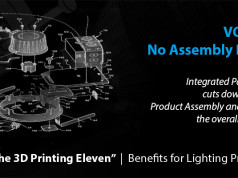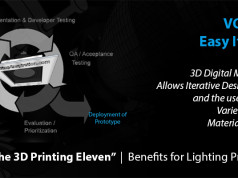“ADOPTION OF 3D PRINTING RESULTS IN SHORTENED CYCLE TIMES AND FASTER MARKETING”
Speed is a fundamental advantage of 3D printing that is critical in the race to bring new lighting products to market. When asked, most all of those performing 3D printing will confirm that speed is important in product development and project planning. But how fast is fast enough, and how is speed measured?
What lighting product designers and manufacturers really want is an efficient manufacturing process: one that has only a few bottlenecks, less manual efforts and a quick response. To discover that kind of efficiency, it is important to understand your company’s operations and to learn about the truth about the processing time of 3D printing.
3D Printing Speed: Short Lead Times
In the daily practice, speed is a relative measure, and when it comes to 3D printing, it is influenced by many variables. Simply dividing manufacturing technologies in “fast” and “slow” buckets is misleading. While some generalizations are fitting, few hold true when considering the entire picture of speed.
“To reliable measure the manufacturing speed, you best clock the full process: Start the timer at the moment you finish your CAD file and stop it when the printed part is ready for use”
The Full 3D Printing Process
The building time, the physical time that a part spends in the 3D printer, is the most common measure of defining process speed. But honestly, it is just one component of the elapsed time that’s needed to complete a full part. The 3D printing process has many different stages, including:
- preparing the print file;
- preparing the print system;
- building of the part;
- post build printer operations;
- post-processing (such as polishing, painting or coating).
Preparing for Print
On the front end, there’s time needed to set up the job including the orientation, supporting, slicing and application of the build style. Many users are surprised about how much time is needed to prepare the printer, to load or to swap the print materials and to warm-up the printer, especially if you come from a ‘cold start’. Before running a print job, you might need to wait anywhere from just ‘several’ minutes to even ‘a couple of’ hours.
Post-building process
Right after the build process is finished, two steps still have to be taken: ‘post-build idle’ and ‘post-processing’. After a part is built parts may have to drain, binders may need time to harden or chambers may have to cool, depending on the process. These delays vary from almost no time to many hours. For some manufacturing technologies, build time is effectively doubled because parts have to cool for nearly as long as they were building.
Once you can handle the parts, it’s time to post-process them. Every technology requires some form of post-processing, and the time to complete this step varies widely. For an accurate sense of delivery speed, you need an understanding of the actions needed. Depending on the process, these steps might include: cleaning of the parts, post-curing, de-powdering, support removal, polishing or other steps.
Automated or Manual?
When having limited resources available, don’t forget to take into account the impact of labor-dependent processes on delivery time. What happens if your staff is not ready and waiting for the job? And how much time will they need to complete the action? For every manual step, without resources being in place, delivery time can swell. This can become a critical factor and even a bottleneck to delivery. The advantages of automation are most notable in the post processing phase. For example, a 3D printing technology that spits out dozens of small, highly detailed parts in a few hours may have delivery time measured in days if each part requires more than a few minutes for support removal and finishing.
This scenario becomes even more impactful if a skilled design engineer is needed. For example, removing supports made of the same material as the part is not a job for an unskilled worker. It takes an experienced hand and keen eye to discern where the part stops and supports begin. If your resources are so thin that you will be doing all this post processing by yourself, you’ll have to consider whether you have the time to take on this work or not.
Build Time Variances
Build time exists of many different variables, some that you select and others that are fixed. In the fixed category, consider the details of the parts. It is widely known that the height of the part drives time: For every technology, the taller the part, the longer the build time. But many overlook other factors, such as material volume, surface area and part footprint and configuration. Each might add hours to the build time!
Time is a crucial factor when using 3D printing for your purposes and a crucial advantage in product development. However, time is also a benefit that’s influenced by various pre- and post-process variables. To learn the truth about speed, you should discover what affects time and how that translates to your parts. There will be a follow-up post in the next weeks on this extensive topic. Make sure you stay connected!
References:
[1] The Truth about Speed: Is the hare really the fastest? White Paper by Rob Winker, Stratasys, Inc.








